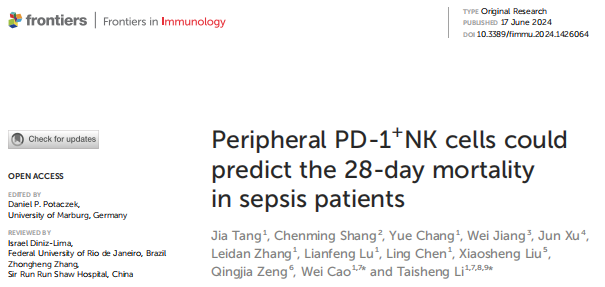Recently, the team led by Professor Li Taisheng, Director of the Department of Infectious Diseases of PUMCH, published papers in high-impact international journals, exploring the important applications pertinent to various lymphocyte subsets in immunosenescence and prognosis prediction of sepsis. Both studies were supported by the National High Level Hospital Clinical Research Funding.
The immune system plays a crucial role in human survival and disease occurrence. Lymphocytes are important to maintain the body’s immune function and can go a long way towards unraveling the mysteries of aging and disease. Immunosenescence is a process of immune dysfunction that accompanies aging. Previous studies have mostly focused on disease-related changes in various lymphocyte subsets. However, the fluctuations in the number and phenotypes of lymphocyte subsets that accompany aging have not been thoroughly investigated, especially for new indicators in peripheral blood such as PD-1 and Ki67.
Recently, Professor Li Taisheng’s team found that some previously neglected lymphocyte subsets play a very important role in immunosenescence and prognosis prediction of sepsis, and their research findings were published in high-impact international journals.

The team studied the humoral and cellular immune parameters of 150 healthy donors aged over 18. The study once again validated that with increasing age, the expression of CD28 on T cells gradually decreases, while the proportion of activated lymphocyte subsets such as CD38 and HLA-DR gradually increases. The study also found that the number of various lymphocyte subsets varies by age group and gender, such as CD4+CD45RA+CD62L+T cells and CD4+CD45RA+CD31+T cells. The team proposed that age was positively associated with PD-1+ and CD8+Ki-67+T cells.
The above research findings were published in the journal "Aging". This study verified the reliability of traditional aging biomarkers. It also demonstrated differences in immune parameters between young and old people, providing immunological clues for future aging research and new insights for clinical monitoring and prevention of certain diseases.

Sepsis is a life-threatening disease with significant global health burdens. Immune dysfunction, especially when different immune cells in peripheral blood are involved, is a pivotal feature of sepsis and an early warning sign as well.
Professor Li Taisheng’s team conducted a clinical study on the relationship between sepsis and peripheral blood immune cell subsets. A total of 100 septic patients and 89 age- and sex-matched healthy controls were enrolled. They analyzed the immune profiles of sepsis patients, identified potential biomarkers, and assessed their association with 28-day mortality. After analysis, the research team found that the percentages of CD38+CD8+T cells, PD1+NK cells, and HLA-DR+CD8+ T cells were significantly increased in sepsis patients. Moreover, by monitoring PD1+NK cell levels in combination with the Sequential Organ Failure Assessment (SOFA) score, the 28-day mortality risk of sepsis patients could be accurately predicted.
This study provides new insights into the association between PD1+NK cell profiles and prognosis of sepsis. Peripheral immunophenotyping could potentially stratify the septic patients and identify those with a high risk of 28 day mortality. The research findings were published in “Frontiers in Immunology”.
In 1999, Professor Li Taisheng’s team was the first to establish a peripheral blood lymphocyte subset testing platform in China. Over the past two decades, the application of this testing platform has provided substantial theoretical insights for the clinical diagnosis and treatment of various viral infectious diseases, such as the infection of HIV, HBV, herpes virus, SARS, and influenza virus; in addition, the flow cytometry evaluation of lymphocyte subsets has been widely applied in the fields of autoimmune diseases, tumors, organ transplantation, and health management, among others, establishing itself as an important immune monitoring tool.
Professor Li Taisheng stated that the Department of Infectious Diseases of PUMCH would integrate the analysis of these specific lymphocyte subsets into their routine clinical practice. He is optimistic that this approach will gradually unlock further research breakthroughs that have a tangible impact on patient care.
Written by Liu Huiting and Yan Xiaobo
Pictures courtesy of the Department of Infectious Diseases
Translated by Liu Haiyan
Reviewed by Liu Huiting and Wang Yao
